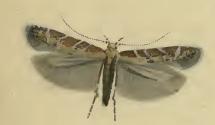The United Party of New Zealand, a party formed out of the remnants of the Liberal Party, formed a government between 1928 and 1935, and in 1936 merged with the Reform Party to establish the National Party.

Aristotelia serrata, commonly known as wineberry or in the Maori language makomako or just mako it is a flowering plant tree of Elaeocarpaceae in the genus Aristotelia, found in the North Island, South Island and Stewart Island of New Zealand.

Fifty Million Frenchmen is a 1931 American pre-Code musical comedy film photographed entirely in Technicolor. The film was produced and released by Warner Brothers, and was based on Cole Porter's 1929 Broadway musical Fifty Million Frenchmen.

Aristotelia is a genus of moth in the family Gelechiidae. Well-known species are food plant specialists, and diverse hosts are used - Salicaceae, Solanaceae, Rosaceae, Fagaceae, Fabaceae, Asteraceae.

The United Government of New Zealand was the government of New Zealand from 1928 to 1931, defeating the long-lived Reform Government. The United Party had been formed in 1927 from the remnants of the Liberal Party under Sir Joseph Ward, who had made a political comeback. They did not manage an outright win, but formed a government with Labour Party support. However, Ward was in poor health and was eventually succeeded by George Forbes. The new cabinet was notable for its inexperience, with four ministers not having sat in the House of Representatives previously.

Mary Forbes was a British-American film actress, based in the United States in her latter years, where she died. She appeared in more than 130 films between 1919 and 1958.

Aristotelia is a genus with 18 species, of tree in the family Elaeocarpaceae. It is named in honor of the Greek philosopher Aristotle.
Aristotelia may refer to:

Aristotelia chilensis, known as maqui or Chilean wineberry, is a tree species in the Elaeocarpaceae family native to South America in the Valdivian temperate rainforests of Chile and adjacent regions of southern Argentina. Limited numbers of these trees are cultivated in gardens for their small fruits, known as maqui berries. Most of the fruits commercially marketed come from the wild.

Aristotelia roseosuffusella, the pink-washed aristotelia, clover aristotelia moth or garden webworm, is a moth in the family Gelechiidae. It is found in North America, including Alabama, Georgia, Illinois, Kentucky, Maryland, Massachusetts, Michigan, New Jersey, Oklahoma, Ontario, South Carolina, Tennessee and Virginia. The species was first described by James Brackenridge Clemens in 1860.

Aristotelia brizella is a moth of the family Gelechiidae. It is found in most of Europe, except Ireland, Switzerland and most of the Balkan Peninsula. Outside of Europe, it is found in North Africa and the Near East.
Aristotelia decoratella is a moth of the family Gelechiidae. It is found in Portugal, France, Italy, Switzerland, Germany, Hungary, Slovakia, Bulgaria, Russia, as well as on Sardinia, Corsica and Sicily. It is also present in Asia Minor.
Anomologinae is a subfamily of moths in the family Gelechiidae.
Aristotelia amelanchierella is a moth of the family Gelechiidae. It was described by Annette Frances Braun in 1925. It is found in North America, where it has been recorded from Oklahoma, Utah, Washington and West Virginia.
Aristotelia diolcella is a moth of the family Gelechiidae. It was described by William Trowbridge Merrifield Forbes in 1931. It is found in Puerto Rico.
Aristotelia lignicolora is a moth of the family Gelechiidae. It was described by William Trowbridge Merrifield Forbes in 1931. It is found in Puerto Rico.
Aristotelia planitia is a moth of the family Gelechiidae. It was described by Annette Frances Braun in 1925. It is found in North America, where it has been recorded from Utah.









